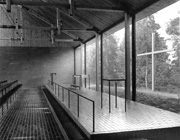
The Otaniemi Chapel
The International Carlo Scarpa Prize for Gardens
XX Annual Award, 2009
A small masterpiece by the architects Kaija (1920-2001) and Heikki (1918-) Siren, the Otaniemi Chapel has stood since the mid-1900s in a forest glade on the highest point of the peninsula to which the distinguished campus of the Helsinki University of Technology was moved at around the same time. The masterly simplicity and transparency of the building draws revelation of the sacred from nature and confers sense and measure on a space that provides an educational experience, spiritual and social, cultural and musical, for the entire community of families and students. Nature, architecture and society thus come together in this remarkable crucible of form and life, the site to which the Jury has unanimously decided to award the seal of the xx International Carlo Scarpa Prize for Gardens.
The site embodies the fundamental features of an anthropology for which nature, and in particular the forest, which covers two thirds of Finland, is the principal source of life, the most abiding and profound link with its history and a comforting, contemplative sanctuary. In the minute scale of a work commissioned by a student association, in the subdued, oblique light of its spaces, what strikes one most of all is the primacy of nature, the pantheism almost, which informs the stones and the mosses, the sea glimpsed beyond the trees and the houses, the bricks and the wood of which the chapel is built and the geometry of parallel vertical lines through which the firs and the birches set scale and rhythm for human spaces.
The hierophantic task of nature is clear here; indeed the site proclaims as much through its language of signs and symbols conveying ancient, universal meanings. The usual iconography of the devotional setting is replaced by a glass window that takes up the entire wall of the apse. Astonishingly, the forest is thus brought into the rectangular hall of the church and given the leading role, a role which is underlined by the analogy of trunks and branches with the wooden rafters and slender tie beams. Nature and architecture make use of the same materials yet remain radically different. Their very otherness draws them into dialogue and together they set the defining criteria of the place, the space, time, light, sound and silence that lead to a uniquely intense and profound perceptive experience.
